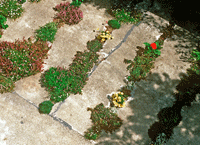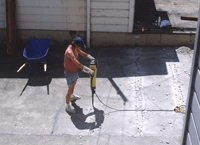Two posts ago I mentioned the Crack Garden, a winner in this year’s ASLA awards program that made me think in a new way about dealing with too much concrete. Ryan over at Dry Stone Garden has some different thoughts on the project that are worth a read.
And as long as we’re talking about reclaiming space from what used to be paved over, let me show you a few shots of my front porch. (Notice how fanatically I staged the space for these photos, including coiling the leaky old hose off in the corner. That’s a level of creativity you never see in the garden design mags.)
The area was all concrete until two, three years ago. This was from the years when a lot of concrete was poured with strips of wood to break the expanse of concrete into neat rectangles. Nice idea, but over the years the wood rots. The concrete shifts.
So I dug out all the decaying wood with a chisel. Next John and I spent a couple hours with a sledgehammer removing some of the big squares of concrete, and then I poured black-pigmented cement to grout between some of the slabs.
I probably didn’t do enough to prepare the ground. Why spend time doing that when there’s bare dirt where you can put plants? So in went some blue fescue in a grid pattern. (Fortunately a few of the plants died, breaking up what would be a cliche of little blue fescues all lined up neatly in their rows.) And then a plant of red shisu for contrast, two standing stones, three stepping stones, a potted euphorbia, gravel mulch and the coiled garden hose to complete the picture. (The shisu is an herb that dies back every year, but it reseeds like crazy, letting you decide where you want some dark red foliage this year.)
Okay, ASLA. I’m ready for my Honor Award.





 (Photo: Tom Fox)
(Photo: Tom Fox)


